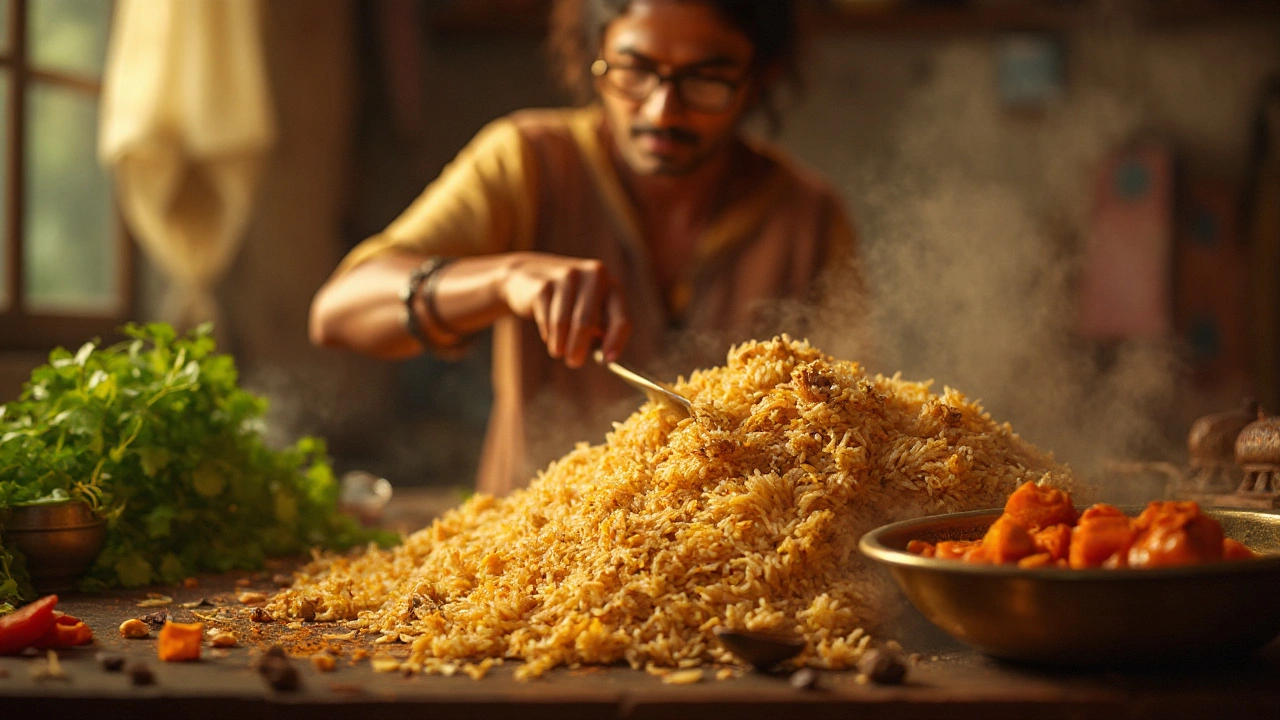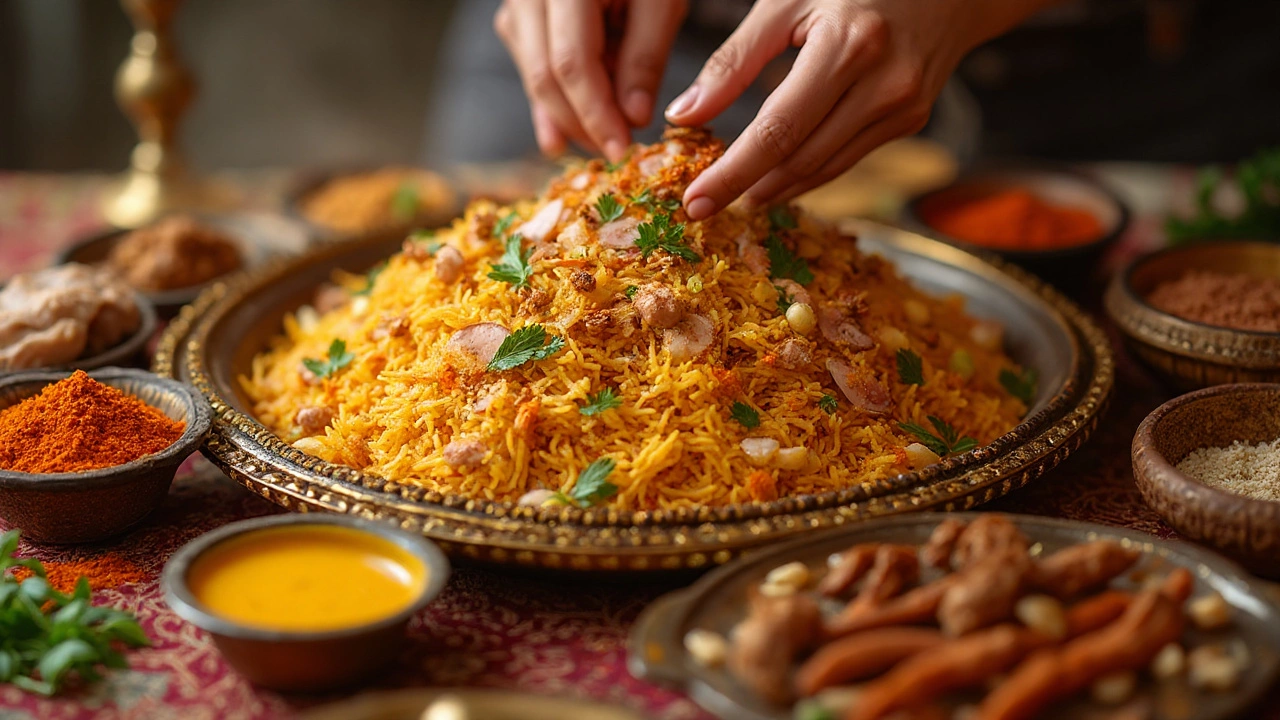Secret Ingredients That Make Biryani More Tasty: Expert Tips & Techniques
 Aug, 6 2025
Aug, 6 2025
Kolkata folks argue their biryani is supreme, Hyderabad calls theirs royal, and in Mumbai, you’ll find fierce loyalty to local flavors. Biryani can turn friends into rivals at the dinner table. With just one spoonful, you know if you’ve got a hit or just another ordinary rice dish, so what’s behind this alchemy? Think about the last time someone brought home biryani in a piping-hot handi and the whole room filled with an irresistible aroma. It’s never just rice, meat, and masala. There are secrets, shortcuts, hacks, and even a few stubborn rules—passed down from one kitchen to another. If you’ve ever wanted to crack the code, you’re in for a treat.
The Heart of Biryani: Rice, Meat, and Masala
Start with rice, and not just any cheap variety from the grocery aisle. True biryani magic begins with aged basmati rice—grains that are long and dry, not sticky or clumpy. Everyone I know swears by soaking the rice for at least 30 minutes before cooking. This helps keep the grains separate once cooked. These small tricks can make a biryani leap from dull to dazzling. Rice isn’t just a carrier; its texture makes or breaks the dish. The saffron and kewra water are like jewelry for the rice, giving it a color and aroma that turns every bite into a celebration.
The jeera samba rice used in South Indian biryani brings totally different vibes. The grain is shorter, almost round, releasing more starch for a stickier, cozier feel. If you secretly love some gravy mixed through your grains, samba rice will be your best friend. But the game-changer is always the meat or veggies. Goat meat (mutton) is considered the gold standard for meat biryani, slow-cooked until it melts at the touch of a fork. Marination matters more than you might think. When I make biryani at home, I soak the meat in yogurt, ginger-garlic paste, red chili, salt, and a touch of lemon juice for at least two hours, but overnight is better.
Now, the masala. Freshly ground is non-negotiable if you’re going for taste that knocks people off their seats. In Mumbai’s iconic Irani cafes, chefs grind cardamom, cloves, bay leaves, and cinnamon each morning. Store-bought powders? They just don’t bring the same warmth or deep spice. That whole masala thrown in with the meat perfumes the entire handi. Green chilies keep things sharp, black peppercorns add surprise heat, and fried onions are the secret weapon—caramelized golden, never burnt. You can add a little rose water or dried plums if you love a sweet, floral edge—the Awadhi style.
Little Details That Pack a Punch
If you want flavor in every bite, you can’t treat biryani as just a one-pot meal. Every step needs its time in the sun. Dhum or slow steaming is what gives biryani its layered taste. It’s like letting all those flavors have a group chat before they arrive at the party. Layering is the old-school technique for a good reason. You start by spreading a layer of partially cooked rice at the bottom of your handi, then follow with marinated meat or vegetables, drizzle some saffron-infused milk, scatter fried onions, and repeat. Every single layer is seasoned properly; nothing left bland. The final touch—a tight seal of dough around the lid—locks in the steam, and with it, all the perfumes of spice and meat.
One underrated tip: never crowd the handi. Give everything room to breathe; otherwise, you’ll get a mushy mess. I’ve made this mistake in tiny Mumbai kitchens more times than I’d like to admit. Another winner is roasting the spices just until they release a little smoke. It opens up their essential oils and makes your kitchen smell like a festival. My friend in Lucknow once told me, “If your fingers don’t smell like kewra and ghee for hours, have you even made a real biryani?”
Ghee really is the quiet hero. A judicious spoonful changes the whole character of the dish, giving each grain a beautiful shine and hint of nuttiness. Want to know what separates restaurant biryani from homemade? Patience. Chefs wait for the meat to be tender and masala to cling to every piece. No shortcuts. They sprinkle a handful of mint and coriander leaves just before sealing, packing in color and zest. Balancing those fresh herbs over rich spices keeps the biryani from feeling too heavy or one-dimensional. And, yes, that squeeze of lemon just before serving brightens up the whole handi.
| Biryani Element | Pro Tip |
|---|---|
| Aged Basmati Rice | Soak for 30-45 min, use double the water for perfect texture |
| Meat Marination | Marinate overnight for tenderness and deep flavor |
| Spices | Always use fresh whole spices and roast slightly before adding |
| Onions | Caramelize on low heat for sweetness, never burn |
| Layering | Alternate rice and meat evenly, season each level |
| Herbs | Add mint and coriander right before sealing for a fresh kick |

Regional Secrets and Stories
The best biryani isn’t just about the ingredients. It’s the stories, rituals, and even geography. Take Dindigul biryani from Tamil Nadu—assertive black pepper, short jeera samba rice, and cubes of tender meat cooked in copper pots. Then there's the glorious Hyderabadi dum biryani, where the marinated mutton cooks inside the handi with half-cooked rice and bursts out with layers of flavor as you dig in. In Kolkata, potatoes are lovingly tucked between the rice, so every bite is like a mini adventure. Legend says the Nawab of Bengal added potatoes and eggs to make sure there was enough to go around for guests when meat was scarce. That trick still works when you’re feeding a hungry family.
The Kerala biryani comes with a coastal twist—a hit of coconut milk, fried curry leaves, and lots of onions. These tiny swaps change everything. In the North, especially Lucknow, it’s all about subtlety. The spices are balanced so no one flavor takes over; you taste the rice, the meat, and the gentle perfume of saffron equally. Mumbai biryani? It’s a spice lover’s delight—hotter, punchier, and unafraid to throw in everything from nuts to dried fruits. Everyone keeps their recipe close, with each kitchen defending its version as the only right way.
Did you know that in Iran, where the term "biryani" likely has its roots, the dish is more about meat and less rice, served separately rather than layered? Over time, as biryani traveled through the kitchens of royalty and commoners, it morphed into the complex, soulful biryani we know today. There’s a reason UNESCO has listed the art of making Hyderabadi biryani as an Intangible Cultural Heritage.
Every city, every household claims their twist as the best, and honestly, each version is worth celebrating. More than a meal, biryani is a culinary passport that’s evolved with migrations, wars, marriages, and celebrations. In my home, I still use my mother-in-law’s trick: she quickly fries the meat before layering—it deepens the flavor and helps keep the grains intact. Some families use stock to cook the rice instead of just water, giving the grains more backbone. These choices are all about layering taste upon taste, until every mouthful feels uniquely yours.
Expert Tips to Make Your Biryani Unforgettable
Biryani is equal parts science and emotion. Here are a few time-tested ideas you won’t find in every recipe book. Tea-infused water for the rice gives it a gorgeous deep color—just toss in a black tea bag as you parboil. For a real party trick, drizzle a tiny bit of ghee on the sides of your handi, not just on top. As it steams, the ghee trickles through, cozying up the flavors. Always use bone-in meat if you’re going for mutton or chicken—the bones add that slow-cooked, broth-y richness.
If you want a veggie biryani that actually rivals the classic, don’t just throw in raw vegetables with the rice. Char the carrots, beans, and peas first in a bit of ghee, then marinate with the same spices. Paneer cubes marinated with yogurt and browned on all sides work wonders. When adding nuts and dried fruits—like cashews and golden raisins—toast them lightly in ghee before layering. That burst of sweet-salty crunch breaks up the richness in the best way.
For people who love an extra punch, one hidden gem is rose petals or rose essence (natural, please). Used sparingly, it pushes fragrance up to eleven. Just don’t overdo it, or you’ll be eating perfume with your rice. If you want pure restaurant-style biryani, make sure your handi is a heavy-bottomed one. Chefs love their thick aluminum or copper pots because they distribute heat evenly—this means no burnt patches at the bottom. Making biryani for a crowd? Let it sit, covered, for 15 minutes after you take it off the heat. The carry-over cooking lets flavors settle, and your rice turns even fluffier.
If you ever doubted the role of a well-made raita or sharp onion salad, trust me, they bring each grain alive and help balance all that spice. In our home, Arjun gets a spicy green chutney alongside his biryani, swears it wakes up his tastebuds. You might laugh, but a small touch of sugar in the masala for Mumbai biryanis actually tames the spice and rounds off the flavors.
Biryani is that rare dish where every element—rice, meat, spice, aroma—wants to lead, and yet the best versions always get them to sing in harmony. The more attention you give to each step, the more unforgettable the final dish. Soak the rice, marinate with patience, grind your own spices, and treat layering like an art. That’s what pushes biryani miles ahead of ordinary rice dishes and keeps us coming back for second—and third—helpings every time.